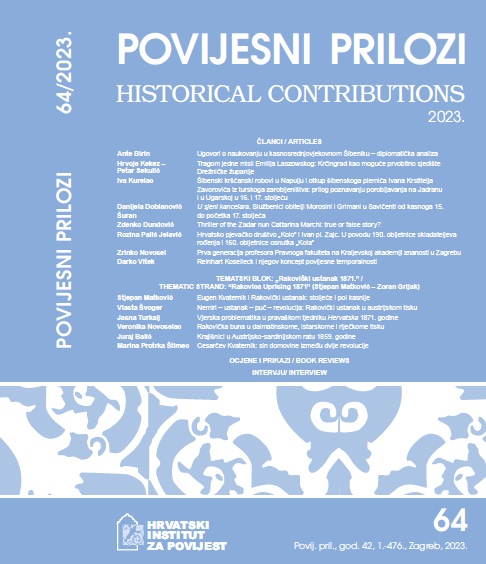Christian Slaves from Šibenik in Naples and the Redemption of Šibenik’s Nobleman Iohannes Baptista Zavoreus from Turkish Captivity: New Insights on Enslavement in the Adriatic and Hungary during the 16th and 17th Centuries
DOI:
https://doi.org/10.22586/pp.v42i64.23541Keywords:
Šibenik, Naples, Esztergom, Ottomans, Venetians, slaves, captives, Christians, Iohannes Baptista Zavoreus, Dominicus Zavoreus, Morlacs, Fifteen Years WarAbstract
Starting from the insufficient scholarly research of enslavement and slavery in Šibenik and its district during the Renaissance and the early modern period, which coincided with intense Ottoman incursions, this article analyses and presents two historical sources from the first half of the 16th and the beginning of the 17th century. These sources offer first-hand testimonies regarding the fate of individuals who were enslaved and taken from the border areas to the Ottoman Empire, specifically from the Šibenik Hinterland and Hungary. The first document (National University Library, Zagreb, Collection of Manuscripts and Old Books, shelf mark: R-3931/4, Šibenik. Documenta ad illustrandam historiam civitatis Sibenicensis) focuses on a group of Christian slaves (Morlacs) from Šibenik and the part of its district under Ottoman administration, who were forcefully taken to Naples, probably in the first half of the 16th century, where they were considered Turks. The second source (Šibenik Diocesan Archive, Šibenik, 18/1: Šibenik Diocese, Diocesan Curia, vol. 48, Liber diuersorum) presents the testimony of the Šibenik Chapter concerning the redemption of Šibenik’s nobleman Iohannes Baptista Zavoreus, the son of Šibenik’s humanist and historian Dominicus Zavoreus (ca. 1540-1608), from Turkish captivity in 1606. He had been captured while involved in the Hungarian military forces defending Esztergom against Ottoman attacks in 1605. Both sources are contextualized within the historical circumstances of their creation and then examined in the broader scholarly knowledge of enslavement in the Adriatic and Hungary during the Renaissance and early modern period. The research aims to determine the extent to which the fate of slaves and captives from the Šibenik area aligns with the general treatment of slaves and prisoners during that time. The findings confirm the hypothesis put forth by N. Budak that individuals from all social classes were at risk of being captured and that despite legal prohibitions in the Eastern Adriatic communes, including Šibenik, enslavement remained a widespread activity aimed at profiting from the sale or purchase of enslaved individuals. The document from the Šibenik Diocesan Archive about the redemption of Iohannes Baptista Zavoreus from Turkish captivity also reveals previously unknown facts about his life, contributing to a better understanding of the history of the Šibenik noble family Zavoreus and their involvement in anti-Turkish wars.
Downloads
Published
How to Cite
Issue
Section
License
Copyright (c) 2023 Authors and journal

This work is licensed under a Creative Commons Attribution-NonCommercial 4.0 International License.







